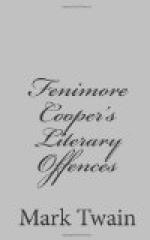The boat has passed under and is now out of their reach. Let me explain what the five did—you would not be able to reason it out for yourself. No. 1 jumped for the boat, but fell in the water astern of it. Then No. 2 jumped for the boat, but fell in the water still farther astern of it. Then No. 3 jumped for the boat, and fell a good way astern of it. Then No, 4. jumped for the boat, and fell in the water away astern. Then even No. 5 made a jump for the boat—for he was a Cooper Indian. In the matter of intellect, the difference between a Cooper Indian and the Indian that stands in front of the cigarshop is not spacious. The scow episode is really a sublime burst of invention; but it does not thrill, because the inaccuracy of the details throws a sort of air of fictitiousness and general improbability over it. This comes of Cooper’s inadequacy as an observer.
The reader will find some examples of Cooper’s high talent for inaccurate observation in the account of the shooting-match in The Pathfinder.
“A
common wrought nail was driven lightly into the target,
its
head
having been first touched with paint.”
The color of the paint is not stated—an important omission, but Cooper deals freely in important omissions. No, after all, it was not an important omission; for this nail-head is a hundred yards from the marksmen, and could not be seen by them at that distance, no matter what its color might be.
How far can the best eyes see a common house-fly? A hundred yards? It is quite impossible. Very well; eyes that cannot see a house-fly that is a hundred yards away cannot see an ordinary nailhead at that distance, for the size of the two objects is the same. It takes a keen eye to see a fly or a nailhead at fifty yards—one hundred and fifty feet. Can the reader do it?
The nail was lightly driven, its head painted, and game called. Then the Cooper miracles began. The bullet of the first marksman chipped an edge off the nail-head; the next man’s bullet drove the nail a little way into the target—and removed all the paint. Haven’t the miracles gone far enough now? Not to suit Cooper; for the purpose of this whole scheme is to show off his prodigy, Deerslayer Hawkeye—Long-Rifle-Leather-Stocking-Pathfinder-Bumppo before the ladies.
“‘Be all ready to clench it, boys I’ cried out Pathfinder, stepping into his friend’s tracks the instant they were vacant. ’Never mind a new nail; I can see that, though the paint is gone, and what I can see I can hit at a hundred yards, though it were only a mosquito’s eye. Be ready to clench!’
“The rifle cracked, the bullet sped its way, and the head of the nail was buried in the wood, covered by the piece of flattened lead.”
There, you see, is a man who could hunt flies with a rifle, and command a ducal salary in a Wild West show to-day if we had him back with us.




